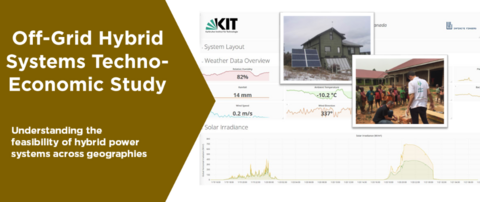Led by KIT scientist Mohamed Mamdouh Elkadragy, this project examines the techno-economic performance of OHRES systems across case study sites in Canada and Uganda where identical systems are installed in the field.
Off-grid hybrid renewable energy systems (OHRES) utilize renewable resources, such as wind and solar power, as well as backup generators to provide electricity for remote communities. A major challenge to the accelerated expansion of these systems is a lack of reliable data assessing the technical and economic performance of systems across diverse geographies. This is due to the lack of standardization in technical and economic analyses for OHRES systems.
Mohamed Elkadragy, a PhD candidate in Renewable Energy at the Karlsruhe Institute of Technology (KIT) embarked on a techno-economic study of OHRES systems with the support of AE4H in 2017. The goal is to carry out a contrastive techno-economic analysis and system design optimization of two similar wind/solar OHRES systems installed in locations with very different climatic and economic conditions - Canada and Uganda. The aim is to understand how technical, economic, and environmental contexts influence the economic feasibility and sustainability of OHRES systems.
Hybrid Off-grid and Decentralized Renewable Electricity Systems Techno-Economic Model (HOTEM)
Contrastive Techno-Economic Analysis Concept for Off-Grid Hybrid Renewable Electricity Systems
Case Studies
| Case Study 1: Sofraa Organization Wakisi School, Jinja, Uganda | Case Study 2: Household in Nemiah Valley, BC, Canada |
| Uganda has one of the lowest electrification rates in Africa, with only 20.4% of the Ugandan population having access to electricity. Near Kampala, the capital of Uganda, the solar irradiance is estimated to be between 1,850 kWh/m2 and 2,150 kWh/m2, indicating strong potential for solar power as a primary power source for an OHRES system. A school building with no electricity or water access has been identified as the installation site. | Though almost all Canadians have access to electricity, many remote Northern communities do not have reliable access. Most of these communities are not connected to the electrical grid and rely on diesel generators, which could potentially be switched to off-grid renewable energy to lessen environmental impact. It is estimated that the Nemiah Valley in British Columbia can achieve between 1,660 kWh/m2 and 1,960 kWh/m2 solar irradiance per year with correctly installed solar panels, making this area a good candidate for an OHRES system that utilizes some solar power. The installation site is a private household that had previously used an off-grid system. |
The road to clean, reliable electricity for remote communities
System Overview
There are five major elements of an OHRES system: renewable electrical energy sources, non-renewable electrical energy sources, electrical energy storage, supplied electrical load and system control/monitoring. In this project, new, state-of-the-art components from industrial partners are being tested, particularly for energy storage and remote monitoring and control.
OHRES Design Criteria and Objectives Summary
An Off-grid Hybrid Renewable Electricity System
A load profile template was developed and used to collect load behaviour information from both locations for the total connected loads (TCL) and average connected loads (ACL) every hour. The annual energy consumption of both case studies falls within the tier-4 level of access in the ESMAP multi-tier framework for household energy use.
Test Bench Lithium ion Lead Acid Hybrid Battery System Structure
Lab setup of system
Hybrid Off-Grid and Decentralized System Techno Economic Model (HOTEM)
The Hybrid Micro Grid Systems (HMGS) techno-economic assessment model was used, which was originally developed for the assessment of standalone systems. The HMGS model was altered with a new optimization algorithm that aims to minimize the loss of power supply probability and the levelized cost of electricity as well as to increase the share of renewables in the system. This was achieved by finding the best composition of generation units and optimum energy storage operation mode. Hybrid Off-grid and decentralized Techno-Economic Model (HOTEM) - Model Structure
A remote system monitoring and weather station (SMWS) was implemented in Uganda to transmit data remotely. This system consists of a self-powered commercial weather station (using a PV panel), hall effect sensors (voltage/current measurement), a controller and data acquisition unit, and a GSM Modem.
The Off-Grid and Decentralized System Data Analysis Platform (OSDAP)
The off-grid system data analysis platform (OSDAP) rule is to analyze the primary data generated through the System monitoring and weather station (SMWS). The Python-based platform is a user interactive interface allows the user to select a dates range and different time zones according to weather station/ system location and works on handling the weather data, field system measured values and system components generated data, through applying handling techniques as data clustering, filtering, null elimination, resolution change, and visualization.
The Platform is developed to be light, operates in the background, cross-platform compatible, adaptable to different Offgrid Hybrid Renewable Energy Systems (OHRES), and integrable with other energy system compilers. However, The cornerstone of the platform is data reliability validation in which to be used for modeling Hybrid generation systems, optimizing off-grid systems and generating techno-economic models.
